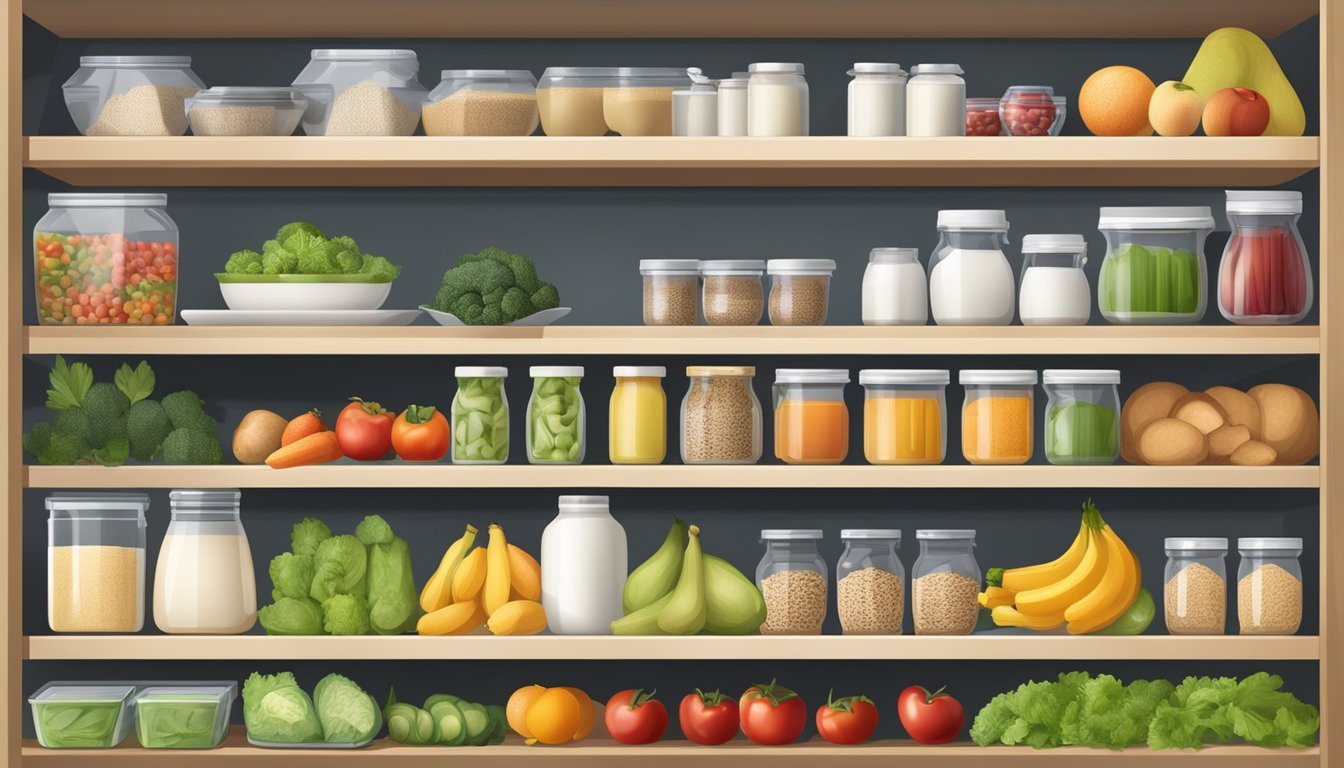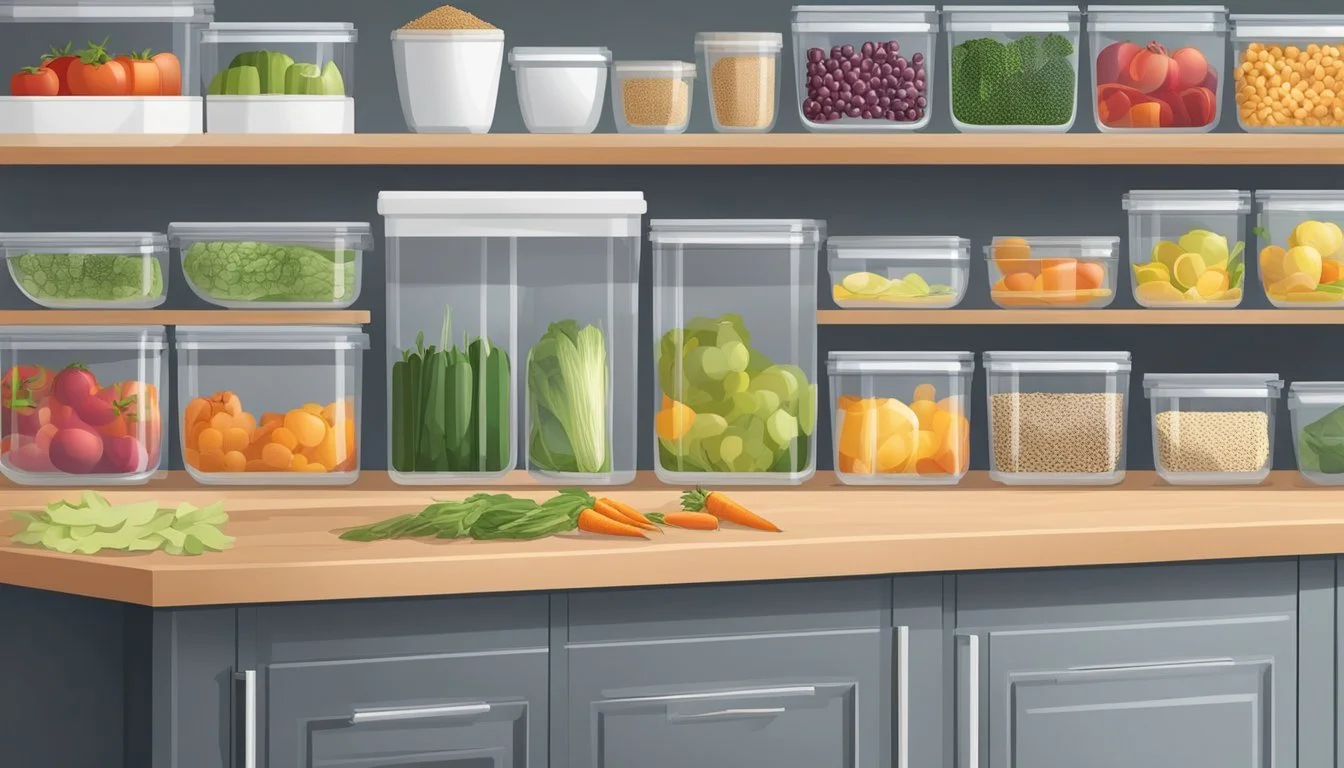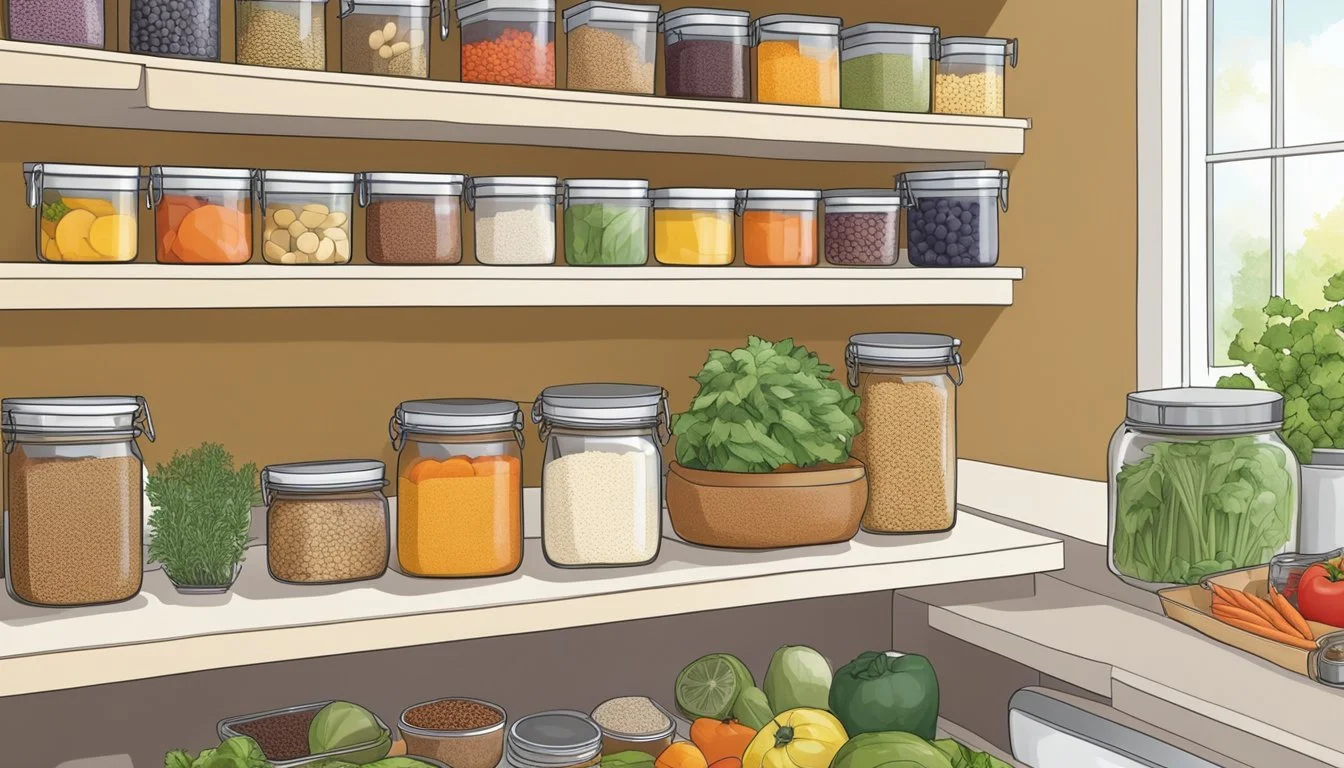Organizing Your Kitchen for a Dash Diet
Streamlining for Heart-Healthy Eating
Adopting the DASH Diet, a longstanding eating approach designed to combat hypertension, requires not just an understanding of the right food choices, but an organized kitchen space to facilitate healthy habits. This diet emphasizes the intake of whole grains, fruits, vegetables, and lean proteins like chicken or fish, while reducing salt intake. Such dietary patterns necessitate a kitchen environment that supports a focus on these food groups for ease of meal preparation and to encourage adherence to the diet's principles.
Organizing your kitchen to align with the DASH Diet involves thoughtful placement of foods and kitchen tools. By making fruits and vegetables more accessible and having whole grains within reach, individuals can more easily make dietary choices that align with the DASH guidelines. Clear labeling and partitioning of storage areas can further streamline the process, ensuring that items like sodas and sugary snacks – which are limited on this diet – are not the focal point of the pantry.
Efficient kitchen organization can also extend to the meal prep process, an essential component for successful adherence to the DASH Diet. Preparing ingredients ahead of time, portioning out servings, and having a plan for the week can simplify following the diet. This not only aids in maintaining the diet but also transforms it into a sustainable lifestyle choice, rather than a temporary fix. With a well-organized kitchen, individuals can more readily enjoy the benefits of the DASH Diet, from improved blood pressure control to overall healthier eating habits.
Understanding the DASH Diet
The DASH Diet is a well-established plan focusing on reducing sodium intake and eating a variety of nutrients that help lower blood pressure and support heart health.
Principles of DASH Eating
The DASH Diet, which stands for Dietary Approaches to Stop Hypertension, emphasizes the following nutritional goals:
Sodium Reduction: Limits sodium to either 2,300 mg or an even stricter 1,500 mg per day.
Rich in Nutritional Elements: Focuses on foods high in fiber, potassium, calcium, and magnesium.
Variety of Foods: Encourages a diet composed of fruits, vegetables, whole grains, and lean proteins such as fish and poultry.
Limited Saturated Fats: Advises against intake of high-saturated-fat foods, like fatty meats and full-fat dairy products.
Moderation in Sweets and Sugared Beverages: Recommends minimal consumption of sweets and beverages high in added sugars.
Benefits for Blood Pressure and Heart Health
Blood Pressure: By reducing the amount of sodium and increasing nutrient-rich foods, the DASH Diet helps to lower blood pressure. This can mitigate the risk of hypertension, a significant concern for cardiovascular health.
Heart Health: The National Heart, Lung, and Blood Institute advocates for the DASH Diet as it contains heart-healthy foods. A consistent pattern of healthy eating as suggested by the diet supports the prevention of heart disease and strokes. It aligns with a focus on nutrition that is beneficial for overall cardiovascular function.
Starting Your DASH Journey
Embarking on the Dietary Approaches to Stop Hypertension (DASH) diet involves taking deliberate steps towards a healthier lifestyle. One begins by understanding their calorie needs and nutritional requirements, two pivotal aspects that inform meal planning and kitchen organization.
Calculating Your Calorie Goal
A person's calorie goal on the DASH diet is dependent on several factors, including age, gender, weight, height, and activity level. To maintain weight, they require a balance between calories consumed and those expended through daily activities and exercise. Weight loss on the DASH diet is achieved by consuming fewer calories than the body uses. Here's a simple guideline based on activity level:
Sedentary: Low daily activity calls for fewer calories.
Moderately active: Integrating moderate activity necessitates a slight increase in calorie intake.
Active: High levels of activity require more calories for energy.
For specific calorie goals, one should consult a healthcare provider or use an online calorie calculator that incorporates their personal measurements and activity level.
Determining Your Nutritional Needs
The nutritional blueprint of the DASH diet focuses on reducing sodium intake, while enhancing the consumption of nutrients that aid in lowering blood pressure. The diet advises on specific intake of macronutrients like proteins and fats, and recommends limiting sugars and certain fats. Here are key nutritional targets to consider:
Sodium: Limit to less than 2,300 mg per day, with an ideal target of 1,500 mg for enhanced benefits.
Proteins: A moderate amount, with emphasis on lean proteins.
Fats: Should be mostly unsaturated, with saturated and trans fats kept to a minimum.
Incorporating whole grains, fruits, vegetables, and low-fat dairy products supports achieving these nutritional goals. By aligning kitchen organization with these targets, making healthier food choices becomes a more manageable part of one's routine.
Essential Foods and Nutrients
Adhering to the DASH (Dietary Approaches to Stop Hypertension) diet requires stocking the kitchen with a variety of whole, nutrient-dense foods. This approach focuses on incorporating an abundance of fruits and vegetables, lean proteins, dairy, whole grains, nuts, and healthy fats and oils, each offering vital nutrients to support heart health.
Fruits and Vegetables
Fruits and vegetables are cornerstones of the DASH diet, celebrated for their rich antioxidant and mineral content. Individuals should strive for:
Fruits: 4-5 servings daily, including options like oranges and cantaloupes.
Vegetables: 4-5 servings daily, emphasizing leafy greens and fiber-rich varieties.
Lean Proteins and Dairy
Lean proteins and dairy provide essential amino acids and calcium without excessive saturated fat.
Lean Proteins: 6 or fewer servings per day, including poultry, fish like salmon, and eggs.
Dairy: 2-3 servings per day of low-fat options such as milk and yogurt.
Whole Grains and Nuts
Whole grains and nuts supply the body with fiber and healthy fats, essential for heart health.
Whole Grains: 6-8 servings daily, choosing whole-wheat bread, brown rice, or oats.
Nuts and Seeds: A few servings per week, such as almonds or seeds, to enhance satiety and nutrient intake.
Fats and Oils
Healthy fats are an integral part of the DASH diet, promoting good cardiovascular health.
Oils: Preference for unsaturated fats, like olive oil, while keeping total fat intake moderate.
Limit Processed Foods: To reduce trans fats and excess sodium commonly found in processed items.
Planning Your Meals
Planning meals for the DASH diet involves balancing nutrients and food groups to combat heart disease with a focus on portion control and a variety of healthy options. Meal plans should emphasize vegetables, fruits, whole grains, lean proteins, and low-fat dairy, while limiting sodium, sweets, and saturated fats.
Designing a Meal Plan
A well-structured meal plan on the DASH diet not only assists in reducing the risk of heart disease but also simplifies grocery shopping and meal preparation. Each meal plan should include a specific number of servings from each food group.
Daily Serving Goals:
Whole grains: 6-8 servings
Vegetables: 4-5 servings
Fruits: 4-5 servings
Dairy (low-fat or fat-free): 2-3 servings
Lean meats, poultry, and fish: 6 or fewer servings
Nuts, seeds, and legumes: 4-5 servings per week
Fats and oils: 2-3 servings
Sweets and added sugars: 5 or fewer servings per week
When it comes to sodium, the recommendation is to aim for less than 2,300 milligrams a day and eventually lower it to 1,500 milligrams if possible.
Breakfast, Lunch, and Dinner Ideas
Breakfast:
Oatmeal: Start the day with a warm bowl of oatmeal topped with a sliced banana and a sprinkle of cinnamon for added flavor without added sugar.
Berry Smoothie: Blend frozen berries with a cup of low-fat yogurt or milk for a quick and nutritious smoothie.
Lunch:
A hearty salad with mixed greens, a variety of colorful vegetables, topped with a portion of grilled chicken or fish for protein, and a dressing made with olive oil and vinegar.
A sandwich on whole-grain bread, filled with lean turkey breast, slices of tomato, lettuce, and avocado, served with a side of carrot sticks.
Dinner:
Grilled salmon (What wine goes well with grilled salmon?) served with steamed broccoli and quinoa. Season with herbs rather than salt to reduce sodium intake.
Stir-fried vegetables with pieces of tofu or shrimp, served over brown rice not only provides a balanced meal but also incorporates a variety of food groups in one dish.
By designing a meal plan that includes these types of foods and sticking to the recommended number of servings, individuals following the DASH diet can enjoy a wide range of meals that support a heart-healthy lifestyle.
Smart Shopping for the DASH Diet
When shopping for the DASH diet, the shopper's focus should be on selecting whole foods rich in nutrients and low in sodium. Understanding the layout of the grocery store and reading food labels carefully are essential steps for adhering to this dietary pattern.
Navigating the Grocery Store
A strategic approach to navigating the grocery store is crucial for the DASH diet. Shoppers should stick to the outer aisles, typically where the fresh produce, dairy, and lean proteins are found. Whole grains are another staple of the DASH diet; one can often find whole-grain bread, brown rice, and whole wheat pasta in these peripheral sections. Planning a route that minimizes exposure to high-sodium and high-sugar processed foods, usually located in the inner aisles, reduces temptation and encourages healthier choices.
Fruits and Vegetables:
Aim for 4-5 servings of each per day.
Choose a variety of colors for a range of nutrients.
Lean Proteins:
Include skinless poultry, fish, and plant-based options like beans.
Limit meat servings to 6 or fewer a day.
Low-fat Dairy:
Seek out skim or 1% milk, yogurt, and cheese.
These items are high in calcium, which is important for the DASH diet.
Reading Food Labels
Understanding food labels is critical when shopping for the DASH diet. Labels carry important information about the nutritional value of food items, which helps in making informed choices that comply with the diet's guidelines. Shoppers should look for key nutrients such as dietary fiber, protein, calcium, and potassium, and be vigilant about the sodium content.
They should also be wary of serving sizes; what may seem like a single serving could be listed as multiple, potentially leading to unintentional overconsumption. A registered dietitian or nutritionist can provide guidance on interpreting food label information correctly.
Key Label Components to Check:
Serving Size: Compare it to the amount you'll actually eat.
Calories: Ensure they align with your daily needs.
Sodium: The DASH diet recommends 2,300 mg or less per day.
Added Sugars: Opt for foods with little to no added sugars.
By applying these shopping strategies, one can effectively follow the DASH diet and make choices that support heart health and overall well-being.
Tips for Cooking and Eating Out
The DASH diet is renowned for its positive impact on heart health and blood pressure management. Key to success with the DASH diet lies in adopting healthy cooking techniques at home and making informed choices while dining out.
Healthy Cooking Techniques
Embracing healthy cooking methods is essential for a DASH-friendly kitchen, aiming to enhance natural flavors while preserving nutritional content. For cooking, individuals should:
Steam or grill vegetables to retain their fiber and nutrient density.
Use olive oil instead of butter to limit saturated fat.
Season dishes with herbs and spices rather than salt to minimize sodium intake.
Incorporating these techniques helps in preparing meals that support blood pressure regulation and overall heart health.
Making DASH-Friendly Choices When Dining Out
Dining out can present challenges for those following the DASH diet due to less control over ingredients and cooking methods. However, individuals can still enjoy a meal out by:
Seeking menu items rich in fruits, vegetables, nuts, and seeds.
Requesting milk or low-fat dairy products to complement their meal.
Asking for food to be prepared with olive oil, and opting for oil and vinegar instead of pre-made salad dressings.
Trimming visible fat off meats and removing skin from poultry.
These strategies ensure that one's dining experience aligns with DASH diet principles, maintaining a focus on nutrient-rich, low-sodium food choices.
Addressing Common Challenges
When following the DASH diet, individuals often face hurdles in reducing their intake of salt and sugar, and managing cravings. The key to success lies in strategizing kitchen organization and food preparation to support these dietary changes.
Reducing Salt and Sugar Intake
Monitoring and reducing the intake of sodium and sugars plays a crucial role in controlling high blood pressure and cholesterol levels. To facilitate this:
Identify and eliminate high-sodium condiments and snacks from the kitchen.
Stock up on herbs and spices as alternatives to salt for flavor enhancement.
Sugars, especially added sugars, should be used sparingly. Consider these steps:
Limit the availability of sweets and opt for fresh fruit to satisfy a sweet tooth.
Replace sugary cereals and beverages with whole fruits and water or herbal teas.
Swap Out Swap In Table salt Herbs and spices Canned vegetables Fresh or frozen vegetables Sweet snacks Whole fruits Sugary drinks Water, herbal teas, fresh juices
Dealing with Cravings and Setbacks
Cravings and setbacks are natural but manageable aspects of dietary change. Here are some tactics to stay on track:
Keep healthy snacks like nuts and pre-cut vegetables readily accessible.
Plan meals to include enough protein and fiber, which can help keep you full and reduce cravings.
Address setbacks by understanding that one slip does not derail the entire effort. Instead:
Acknowledge the setback and revisit the meal plan with a focus on resilience.
Reflect on the triggers that led to the setback and create a plan to cope with them in the future.
If Craving Choose Instead Chips Air-popped popcorn Ice cream Greek yogurt with fresh berries Sweets A piece of dark chocolate
By establishing a supportive kitchen environment and being prepared for cravings and setbacks, individuals on the DASH diet can confidently maintain a health-promoting lifestyle.
Supplementary Lifestyle Considerations
In addition to organizing your kitchen for the DASH diet, one's overall lifestyle plays a critical role in managing health conditions like hypertension, heart disease, and type 2 diabetes. A well-rounded approach involves regular physical activity and stress management to complement dietary changes.
Incorporating Physical Activity
Physical activity is an essential component for those pursuing the DASH diet, especially for individuals aiming to lower the risk of hypertension and heart disease. Regular exercise can also support weight loss efforts. The American Heart Association suggests at least 150 minutes of moderate-intensity aerobic activity per week. This could include:
Brisk walking: 30 minutes a day, five days a week.
Cycling: Consistent, moderate effort on flat terrain.
Swimming: Gentle laps that increase heart rate without overexertion.
Incorporating activities that one enjoys ensures they can maintain a consistent activity level, which is crucial in managing and preventing chronic health conditions.
Understanding the Role of Stress Management
Managing stress is another vital aspect of supporting a DASH-friendly lifestyle. Chronic stress can contribute to hypertension and exacerbate risk factors for stroke and heart disease. Stress reduction techniques can vary, but may include:
Mindfulness meditation: Engages relaxation responses that can lower blood pressure.
Yoga: Combines physical activity with stress-relieving practices.
Individuals should aim to identify stress triggers and establish a routine that incorporates stress-reducing activities, as these practices can also indirectly aid in weight management by reducing the likelihood of stress-induced overeating.
Long-Term Maintenance and Support
Maintaining a DASH diet requires consistent tracking and community support to ensure lasting health benefits, like lower blood pressure and improved cholesterol levels. Regular consultations with a dietitian or nutritionist can be crucial for adapting the diet to one's age and specific health conditions, such as heart disease or cancer risk.
Monitoring Your Progress
One must actively monitor their dietary progress to ensure they adhere to the DASH diet's standards. Individuals should frequently check blood pressure and cholesterol levels, ensuring they're within healthy ranges. They can maintain a food diary or use digital tracking tools to record their intake of foods rich in whole grains, fruits, vegetables, and lean proteins while limiting salt and saturated fats. The insights from this tracking can be reviewed with a healthcare provider to make necessary adjustments.
Table: Key Metrics to Track
Metric Frequency of Check Ideal Range Blood Pressure Bi-weekly <120/80 mmHg Cholesterol Levels Every 4-6 months LDL: <100 mg/dL; HDL: >60 mg/dL Weight Weekly Individual target based on BMI
Engaging with a Support Community
A strong support community can play a pivotal role in maintaining a DASH diet long-term. They should seek interactions with people who share common dietary goals, which can be facilitated through online forums, group meetings, or cooking classes. These communities provide motivation, exchange practical meal preparation tips, and offer emotional support during challenging phases. Engaging with others also allows the sharing of success stories, reinforcing the health benefits of the DASH diet and the prevention of conditions like heart disease and high blood pressure.
Special Considerations
When organizing your kitchen for the DASH diet, it's vital to consider adaptations for different age groups and dietary restrictions, as well as the importance of consulting healthcare professionals for tailored guidance that accounts for individual health metrics and nutritional needs.
Adapting for Different Ages and Dietary Restrictions
The DASH diet emphasizes a variety of vegetables, fruits, and nuts, while recommending low-fat dairy options and limiting intake of full-fat dairy, fatty meats, red meat, and candy due to high fat, sodium, and sugar content. For children or older adults, it's crucial to adjust portion sizes and ensure calcium-intake is adequate for bone health. Those with lactose intolerance may substitute traditional dairy products with lactose-free versions or calcium-fortified alternatives. Additionally, when catering to someone with type 2 diabetes, attention to fruit portion sizes helps manage blood sugar levels.
Children: Smaller portion sizes and frequent meals to support growth.
Older Adults: Adjust textures and supplement with calcium if required.
Lactose Intolerance: Opt for lactose-free dairy or alternatives like almond milk.
Type 2 Diabetes: Be mindful of the carbohydrate content in fruits and whole grains.
Consulting Professionals for Personalized Guidance
Individuals embarking on the DASH diet should consult a dietitian or nutritionist to personalize the eating plan according to their specific needs. A professional can help adjust daily sodium limits, increase or decrease certain food groups to manage cholesterol levels and blood pressure, and advise on moderation with alcohol consumption. They can guide patients on how to replace high-sodium or sugary snacks with healthier options and ensure all nutritional requirements are met, especially if other health conditions like type 2 diabetes are present.
Dietitian Consultation: Tailored advice on meal planning while considering existing health conditions.
Nutritional Needs: Ensuring a balance of macronutrients and micronutrients tailored to an individual’s age and health status.
Recipes and Inspiration
Embarking on the DASH diet involves incorporating a variety of fresh produce, lean proteins, and whole grains while reducing sodium and unhealthy fats. This section will guide the reader through engaging recipe ideas and savvy ingredient swaps to support their DASH diet goals.
DASH-Inspired Recipe Ideas
Breakfast:
Steel-Cut Oats with Almonds and Berries: Start the morning with a heart-healthy bowl of steel-cut oats, sprinkled with almonds for crunch and berries for natural sweetness.
Lunch:
Chicken & Chickpea Soup: Opt for lean poultry like a comforting chicken soup with chickpeas for added protein and fiber.
Dinner:
Baked Salmon with Walnut-Rosemary Crust: Incorporate omega-3 rich salmon, topping it with a mix of crushed walnuts and rosemary for a boost of flavor and healthy fats.
Snack:
Veggie Sticks with Bean Dip: Crunchy vegetables like carrots and celery paired with a creamy bean dip make for a satisfying and nutritious snack.
Creative Substitutions for Common Ingredients
For Cream:
Instead of cream, one can use low-fat dairy options like Greek yogurt to add creaminess to dishes such as pasta sauces or soups.
For Butter:
When a recipe calls for butter, consider substituting it with olive oil or avocado to add healthy monounsaturated fats to your meal.
For Sweets:
Reduce cravings for sweets by opting for fresh fruit, small servings of dried fruit, or a modest portion of dark chocolate.
For Beverages:
Encourage the consumption of plain water, and swap out sugary juices and sodas with herbal tea or water infused with slices of fruit for a refreshing alternative. Alcohol intake should be limited, consistent with the DASH diet principles.
For Salty Snacks:
Ditch the chips and reach for air-popped popcorn or unsalted nuts like almonds for a snack that satisfies without the excess sodium.
Conclusion
Adopting the DASH diet necessitates a well-organized kitchen. By ensuring the kitchen space is functional and that the necessary foods are easily accessible, individuals are more likely to adhere to their dietary goals. The key is to prioritize the staples of the DASH diet: fruits, vegetables, whole grains, lean proteins, and low-fat dairy.
An organized pantry with clear, labeled containers for whole grains can streamline meal preparation. A prepped refrigerator, with pre-cut vegetables and portioned lean meats, supports making healthy choices. Implementing designated areas in the kitchen for these food groups can make following the DASH eating pattern more intuitive.
Portion control tools, such as measuring cups and a kitchen scale, are essential. They assist in maintaining the recommended servings for various foods, which is a cornerstone of the DASH diet. Additionally, keeping a color-coded chopping board system ensures a hygienic environment, reducing cross-contamination especially when handling different food types.
Herbs and spices should replace salt for flavor; storing these in easily accessible racks encourages their use over sodium. Similarly, a well-stocked spice rack promotes culinary creativity while adhering to DASH guidelines.
Lastly, water bottles or a water filter pitcher can encourage increased water intake over sugary beverages.
By rearranging the kitchen to foster these healthy habits, individuals may find maintaining the DASH diet uncomplicated and more sustainable in the long term.












